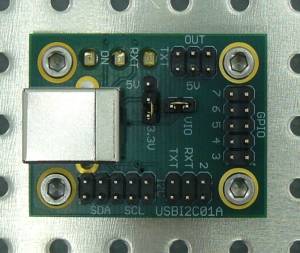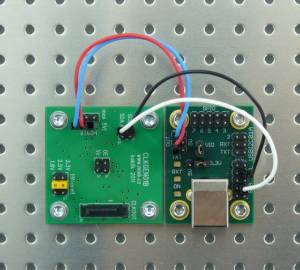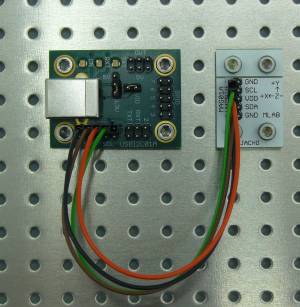Table of Contents
Converter from USB to I²C or SMBus - USBI2C01A
I²C is widely used bus intended for connection of various sensors on short distances. But it is not usual to interface this bus at personal computers because it is not accessible as standard interface. 1)
This module could solve such problem by using the Silicon Labs CP2112 IO, which is direct converter between USB and SMBus or I²C respectively.
Use of the module
The module is enumerated as standard HID device by default. Such behavior allows use without special drivers on every operating system. But some operating systems contain special software for manipulating with I2C/SMBus. In such case is useful to change generic USB HID driver by special driver which connect the MLAB module as standard I2C or SMBus interface.
HIDAPI connection method
HIDAPI is software interface to access HID devices from Linux, Windows or MAC OS. The library works on all mayor computer platforms and architectures. The prerequisite to get HIDAPI work is libusb-1.0 library installed in the system.
Ubuntu 14.04
We should install hidapi and some other packages by running.
sudo apt-get install libudev-dev libusb-1.0-0-dev libhidapi-dev python-setuptools python-pip python-smbus cython
Then we only need package Pymlab
sudo pip install pymlab
Then a new I2C interface may be used in the system, as is mentioned in the page i2c. The module allows even direct access to its GPIO pins.
The example of Python LED blinking script on USBI2C01A IO ports
import hid
import time
try:
print "Opening device"
h = hid.device()
h.open(0x10C4, 0xEA90)
print "Manufacturer: %s" % h.get_manufacturer_string()
print "Product: %s" % h.get_product_string()
print "Serial No: %s" % h.get_serial_number_string()
h.write([0x02, 0xFF, 0x00, 0x00, 0x00]) # sets output to open-drain
time.sleep(0.1)
for k in range(10):
h.write([0x04, 0xFF, 0xFF]) # writes 1 to all 8 outputs pins.
time.sleep(0.1)
h.write([0x04, 0x00, 0xFF]) # writes 0 to all 8 outputs pins.
time.sleep(0.1)
print "Closing device"
h.close()
except IOError, ex:
print ex
print "Done"
This example should be executed as root in default configuration.
The details of HIDAPIO acces to IO ports should be found in this document
Correct setting of access right to USB
If we need access to the USBI2C01 module without root privileges we need to create a file 99-SiliconLabs.rules in /etc/udev/rules.d directory. The file should contain:
SUBSYSTEM=="usb", ATTR{idVendor}=="10c4", ATTR{idProduct}=="ea90", GROUP="plugdev", MODE="0666"
SUBSYSTEM=="hidraw", ATTRS{idVendor}=="10c4", ATTRS{idProduct}=="ea90", GROUP="plugdev", MODE="0666"
Linux Kernel
The Linux is a case of operating system in which system access to I2C or SMBus interfaces currently exists. In Linux is useful to change generic HID driver by new software module in the kernel. The CP2112 IO is directly supported in Linux kernel from 3.16. In that case a loading of i2c-dev Linux kernel module is only required operation. We should do this by sudo modprobe i2c-dev. Then we should see a new I²C interface in system bus list.
kaklik@UST-vyvoj:~$ sudo i2cdetect -l i2c-0 i2c i915 gmbus ssc I2C adapter i2c-1 i2c i915 gmbus vga I2C adapter i2c-2 i2c i915 gmbus panel I2C adapter i2c-3 i2c i915 gmbus dpc I2C adapter i2c-4 i2c i915 gmbus dpb I2C adapter i2c-5 i2c i915 gmbus dpd I2C adapter i2c-6 i2c DPDDC-B I2C adapter i2c-7 smbus CP2112 SMBus Bridge on hiddev0 SMBus adapter i2c-8 smbus CP2112 SMBus Bridge on hiddev0 SMBus adapter kaklik@UST-vyvoj:~$
If we the new interface we should use it exactly same as standard system I²C bus. But CP2112 does not support SMBus Quick Write function. Then we should avoid use of the Quick Write by -r parameter as is demonstrated in following example:
kaklik@UST-vyvoj:~$ sudo i2cdetect -y -r 8
0 1 2 3 4 5 6 7 8 9 a b c d e f
00: -- -- -- -- -- -- -- -- -- -- -- -- --
10: -- -- -- -- -- -- -- -- -- -- -- -- -- -- -- --
20: -- -- -- -- -- -- -- -- -- -- -- -- -- -- -- --
30: -- -- -- -- -- -- -- -- -- -- -- -- -- -- -- --
40: -- -- -- -- -- -- -- -- -- -- -- -- -- -- -- --
50: -- -- -- -- -- -- -- -- -- -- -- -- -- -- -- --
60: -- -- -- -- -- -- -- -- -- -- -- -- -- -- -- --
70: 70 -- -- -- -- -- -- --
kaklik@UST-vyvoj:~$
We see that device with address 0x70, which is the I²C Hub module in that case.
Examples of connected I²C devices
CLKGEN01B
Connection of the clock generator. This case is used in Radio Meteor Detector Station design.



